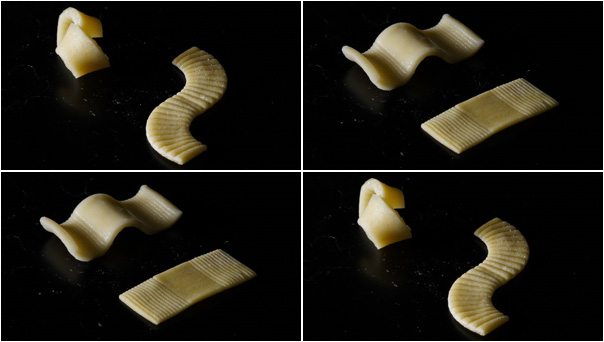Pasta comes in various sizes and shapes, ranging from long and flat (such as linguine and spaghetti) to short types in the shape of shells (conchiglie), corkscrews (fusilli), and many others. Shaped pastas contain a larger volume of air, resulting in greater packaged volume than flat pastas, because shaped pastas take up more space inside the package. Comparing packages of spaghetti (flat) and rigatoni (tube-shaped pasta) manufactured by the Italian food company Barilla, a 454-gram package of spaghetti has a volume of 593 cm3 (92 in.2), while a 454-gram package of rigatoni has a volume of 1479 cm3 (229 in.3), which is about 2.5 times greater. Reducing the volume of food packaging overall is critical to meeting the demands of a sustainable future on Earth. See also: Food packaging

To reduce shaped pastas’ packaged volume, a team of researchers from Carnegie Mellon University in the United States and other cooperating universities have developed a mechanism whereby flat (2D) pasta morphs into 3D shapes in boiling water. By strategically stamping curved, straight, or angled grooves into pasta dough, the researchers were able to control the shape of the pasta after cooking. See also: Boiling

In their proof-of-concept experiments, the researchers prepared a pasta dough containing only semolina (wheat) flour and water and followed a traditional pasta-making process. After rolling the dough to a uniform thickness, stamping proceeded using a mold with grooves on one side and stoppers on each end to control the stamping depth. The cooking process involved placing the grooved pastas in boiling water until they reached their maximum bending shape, which varied in duration from seven to 12 minutes. Testing of both fresh and dried pasta produced comparable morphing results for curved and twisted shapes. Using volumetric calculations to compare flat shapes to morphed shapes, the researchers determined that they could save 59 to 86 percent storage space with morphing pastas. See also: Wheat
In terms of sustainability, a shipping container loaded with flat-packaged morphing pasta could hold, for example, 60 percent more pasta than a comparable pre-shaped pasta, and therefore could reduce carbon dioxide (a greenhouse gas) emissions during shipping by moving more pasta in one trip. In addition to reducing greenhouse gas emissions, flat-packing shaped pasta would also reduce the amount of packaging materials that would ultimately need to be recycled or landfilled. See also: Carbon dioxide; Food; Food engineering; Recycling technology; Sustainability; Transportation engineering





